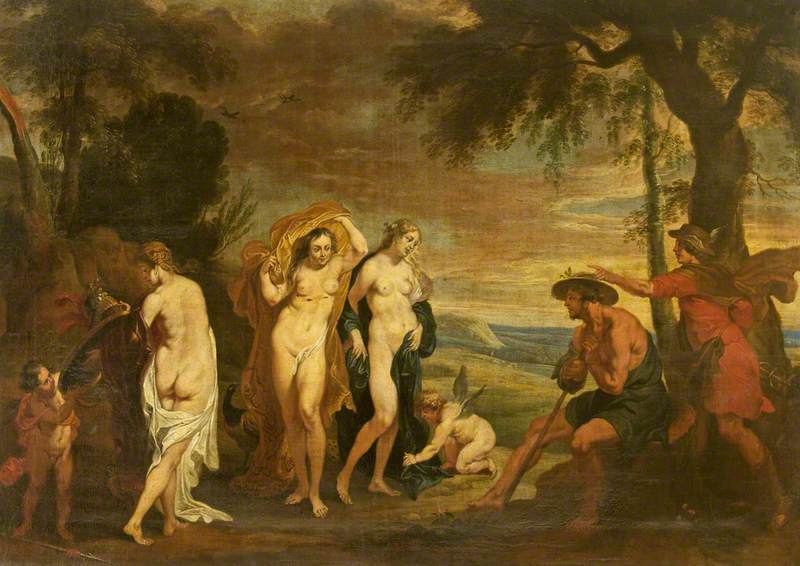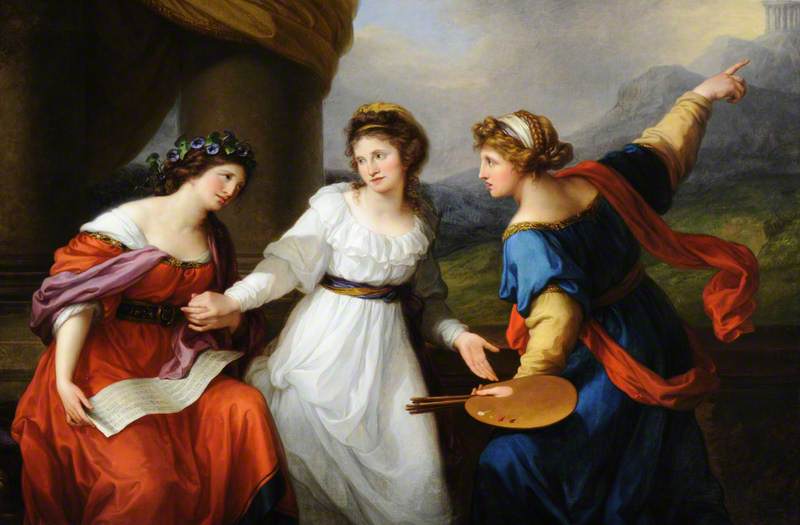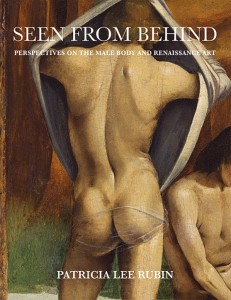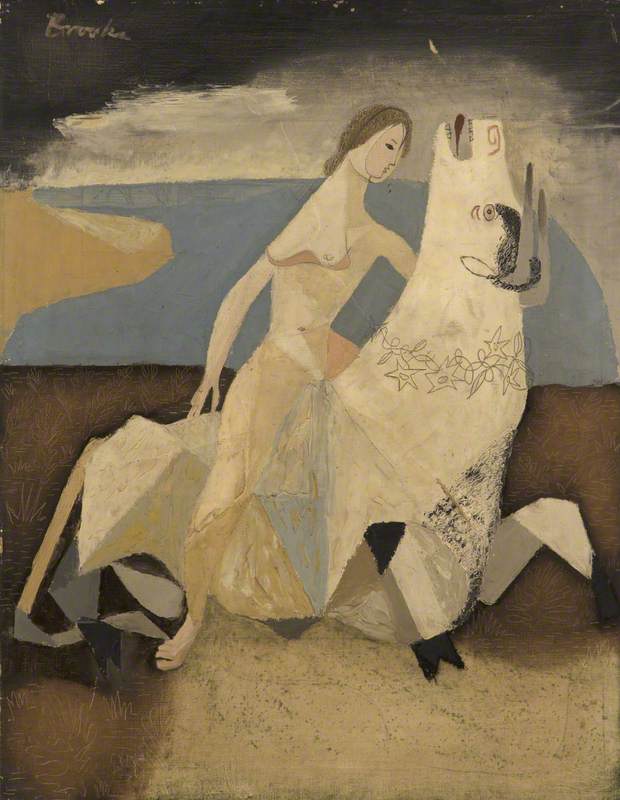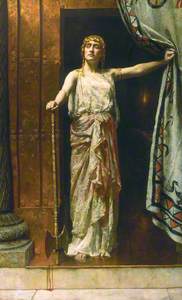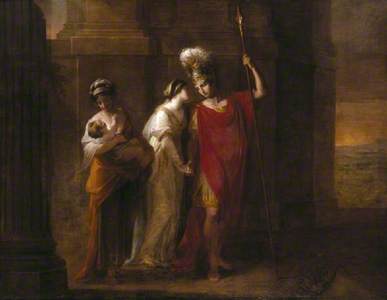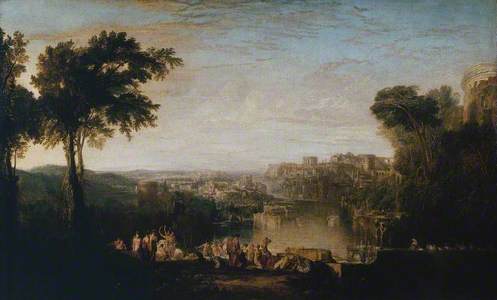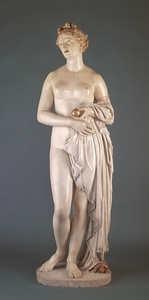It is a vengeful Clytemnestra, resting her arm on a bloodied axe, standing in a reflective moment after polishing off her husband Agamemnon in the bath that provides one of the most memorable images of the British Museum's milestone exhibition 'Troy: myth and reality' (until 8th March 2020).
John Collier's painting in the Guildhall Art Gallery suggests a mad, murderous nonchalance – an unashamed satisfaction in the slaying of her husband.
The infamous commander of the Greek forces, Agamemnon, was accused of sacrificing their daughter Iphigenia to improve the weather for his departing fleet.
Clytemnestra is a small part amongst the main action of the Illiad and Odyssey. But she appears dramatically in the closing section of the exhibition.
The space is devoted to giving the women of the Trojan Wars their say, after being treated for millennia as objects of male lust, seizure, slaughter, and derision, from Helen to the gloomily prophetic Cassandra.
The exhibition is the first in Britain in more than a century to show the dramatic finds of Henry Schliemann (1822–1890), the flamboyant German adventurer and archaeologist who dug a vast trench through a hillside in Turkey to unearth the mythical Troy.
The Wounded Achilles
1825, marble by Filippo Albacini (1777–1858), Chatsworth House 
One highlight is a recreation of the 'jewels of Helen', part of the so-called Treasures of Priam, a lavish headdress and necklace which Schliemann showed off by draping over his young wife.
The ancient artefacts are impressive, but what really survives of Troy after close to 3,000 years is a story, the epic that may have been written, or relayed, by someone called Homer.
Achilles kills the Amazon queen Penthesilea
c.530 BC, ceramic Athenian amphora attributed to Exekias 
The myth of Troy was fodder for the magnificent pottery of the ancient Greeks, and Roman and Etruscan painting. It inspired the art of the Renaissance and succeeding centuries, and is widely represented in UK collections.
Heroes and humans have come to personify these epic mythological tales: Achilles, Odysseus, Paris, Hector, and Virgil's Aeneas (the founder of Rome), to Helen of Troy, Dido the Queen of Carthage, and Penelope.
Schliemann's discoveries in 1871 further fuelled the nineteenth-century fascination with Troy.
Collier – it should be noted – completed a second version of Clytemnestra. In this version found in the Worcester City Museums, a topless female figure with a brazen expression holds a slender knife, which she is about to drop.
In total, there are some 30 painted versions of the Judgement of Paris alone on Art UK. This enduring subject matter sets the stage for the Trojan Wars and its fatal feuds and personalities.
In the tale, Zeus asks the young Trojan prince Paris to decide whom out of three goddesses – Hera, Athena and Aphrodite – is the fairest.
Aphrodite (or Venus, to the Romans) successfully bribes him with the promise of Helen, the world's most beautiful woman, described as having 'the face that launched a thousand ships.' Their elopement is fatal – a casus belli that leads to a decade of war and the fall of Troy.
The National Gallery houses Peter Paul Rubens' painting, which shows the moment when Paris hands the golden apple to Aphrodite – the winner.
The Troy exhibition curators have opted for artist Eleanor Antin's witty if slightly impenetrable 2007 variation on that work, Judgement of Paris (after Rubens).
Judgment of Paris (after Rubens)
2007, chromogenic print, from 'Helen's Odyssey' by Eleanor Antin (b.1935) 
It is a chromogenic print in which Venus brandishes an automatic rifle while the mother figure of Hera (Juno) vacuums the leafy ground.
Of other versions found in British collections, the most striking is maybe Kenneth Dingwall's whimsical 1959 variation in the Edinburgh College of Art's collection. Paris appears in a beachside lifeguard's seat, showing no intention of judging anything. It is rare among artistic tellings of the tale in not showing copious quantities of female flesh.
At the top of this article is The Wounded Achilles by Filippo Albacini (1777–1858), a luminous marble work that can be found in the Devonshire Collection at Chatsworth House.
Achilles is a driving character of the Illiad and also in the exhibition. A symbol of male rage and vulnerability, he can be found thrusting his spear into the neck of an Amazonian queen one moment, and then sulking alone in his tent the next.
Achilles Lamenting the Death of Patroclus
1760–1763
Gavin Hamilton (1723–1798) 
His wrath is finally aroused by the slaying of his beloved friend Patroclus, who is killed by the Trojan hero Hector. The scene was captured by the Scottish Neoclassical painter Gavin Hamilton (1723–1798).
The work Dead Hector by Briton Riviere (1840–1920) found in Manchester Art Gallery, shows the naked body of the Trojan prince, moments after Achilles has killed him and tossed the corpse to the dogs.
In Homer's verse:
'But Hector, Priam's son, Not to the fire, but to the dogs I give... But him the dogs molested not, for Venus night and day...the ravening dogs restrained.'
Riviere's work is characterised by the dogs and other animals built into his tableaux. The painting is dated 1892 but was gifted to Manchester in 1917 in the name of James Gresham – a collector and patron who had recently died.
Gifted in the midst of the First World War, the painting's subject matter – a young man sacrificed in war – resonated powerfully with its time.
Troops Landing on C Beach, Suvla Bay, Later in the Day, 7 August 1915
1919
Norman Wilkinson (1878–1971) 
Another work featured in the show echoes that history.
Troops Landing on C Beach, Suvla Bay, Later in the Day, 7 August 1915 is by Norman Wilkinson (1878–1971), an artist who made sketches from Gallipolli where officers on the Turkish and allied side were well aware that Troy – a contested historical site between east and west – lay across the Dardanelles.
Rupert Brooke, who died on a French hospital ship in the Aegean, wrote en-route: 'And Priam and his fifty sons, Wake all amazed, and hear the guns, and shake for Troy again.'
The painters Angelica Kauffman (1741–1807) and J. M. W. Turner (1775–1851) both widely explored the characters of Homer and Virgil.
Ulysses deriding Polyphemus - Homer's Odyssey
1829
Joseph Mallord William Turner (1775–1851) 
In Turner's Ulysses Deriding Polyphemus, borrowed from The National Gallery, Ulysses (Odysseus) stands on his ship pouring scorn on the blinded Cyclops.
The Arrival of Aeneas at Pallanteum by Claude Lorrain (1604–1682) is in the collection of the National Trust at Anglesey Abbey, with Aeneas arriving on the River Tiber after his flight from Troy, on his way to found Rome.
Turner used themes from Virgil's Aenead in a dozen canvases, at a time when the ruling classes in Britain and other countries liked to claim descent from Aeneas.
His painting of Aeneas and the tragic Dido, features an imaginary Carthage in the background; the landscape is clearly inspired by Thames riverbanks, with Carthage set on Richmond Hill.
Emma Hart (c.1765–1815), Lady Hamilton, as Circe
1782
George Romney (1734–1802) 
Artists from George Romney (1734–1802), using Lady Hamilton as the model for multiple Greek heroines, to the Pre-Raphaelite John William Waterhouse (1849–1917), with Circe as a picture of wanton temptation, to Elisabeth Frink (1930–1993), have filled British collections with the characters of the Trojan wars.
But spare a thought for one player in the story of Troy who has not yet got the pictorial credit he deserves.
British Museum curators, as well as Turkey's head of excavations and other experts widely agree that the 'unsung hero' who pinpointed the site of Troy was the Scottish journalist, geologist, and co-founder and longtime editor of The Scotsman newspaper, Charles Maclaren.
It is time, they say, that he gets proper recognition.
Charles Maclaren (1782–1866), editor of 'The Scotsman' and geologist
(after William Brodie), 1889, marble sculpture by John Hutchison (c.1832–1910) 
Working mostly with academic research from Edinburgh, Maclaren made the link that mythical Troy lay underneath Roman and later remains at Hisarlik, in Turkey, not in the various other sites offered. He wrote up his discovery in 1822, aged 40, and then more definitively in 1863, but it went overlooked – until Heinrich Schliemann picked up the theory, and had the money to go digging.
There is a fairly unremarkable statue of Charles Maclaren in the National Museum of Scotland, and a bust in the National Gallery of Scotland's collection, along with a mezzotint by Edward Burton, after an oil portrait whose whereabouts were uncertain at the time of press. A paltry public record of the man said to be the true discoverer of Troy.
Roman Sarcophagus Lid
(including detail of the Trojan horse), late 2nd C AD, marble 
Scholars will continue to debate just how much of the Trojan Wars are routed, in fact – though the exhibition and its exemplary catalogue note the wider historical and archaeological evidence for one or several clashes between a western Mycenean power and an eastern Hittite civilisation.
The strength of the Odyssey's female characters have fed speculation that the mysterious author was not the grizzled, bearded bard shown in sculptures like that in Pembroke College, but just possibly a woman.
But the drama remains part of the fabric of western art.
Tim Cornwell, freelance arts writer
The exhibition 'Troy: myth and reality' is on at the British Museum from 21st November 2019 to 8th March 2020


